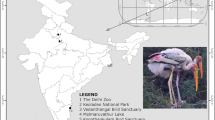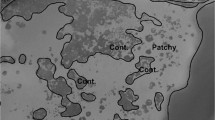Abstract
Emperor penguin (Aptenodytes forsteri) populations are useful environmental indicators due to the bird’s extreme reliance on sea ice. We used remote sensing technology to estimate relative adult bird abundance at two inaccessible emperor penguin colonies in the Ross Sea, Antarctica. We performed supervised classification of 12 panchromatic satellite images of the seven known Ross Sea colonies. We used regression to predict adult bird counts at the inaccessible colonies by relating the number of pixels classified as “penguin” in the satellite images of the accessible colonies to corresponding known adult bird counts from aerial photographs or ground counts. While our analysis was hampered by excessive guano and shadows, we used satellite imagery to differentiate between relatively small (<3,000 adult birds) and larger colonies (>5,000 adult birds). Remote sensing technology is logistically less intense and less costly than aerial or ground censuses when the objective is to document penguin presence and/or large emperor penguin population changes (e.g., catastrophic changes). Improvements expected soon in the resolution of the satellite images should allow for more accurate abundance estimates.





Similar content being viewed by others
References
Ainley DG, Ballard G, Emslie SD, Fraser WR, Wilson PR, Woehler EJ (2003) Adélie penguins and environmental change. Science 300:429
Barber-Meyer SM, Kooyman GL, Ponganis PP (2007) Trends in western Ross Sea emperor penguin chick abundances and their relationships to climate. Antarct Sci (in press)
Barbraud C, Weimerskirch H (2001) Emperor penguins and climate change. Nature 411:183–186
Bargagli R (2005) Antarctic ecosystems: environmental contamination, climate change, and human impact. In: Ecological studies, vol 175. Springer, Berlin
Burn DM, Cody MB (2005) Use of satellite imagery to estimate walrus abundance at Round Island, Alaska. Poster presentation at The December 2005 society for marine mammalogy annual meeting. San Diego, California
Cook RD, Weisberg S (1999) Applied regression including computing and graphics. Wiley, New York
Croxall JP, Trathan PN, Murphy EJ (2002) Environmental change and Antarctic seabird populations. Science 297:1510–1514
Croxall JP, Trathan PN, Murphy EJ (2003) Response to Ainley et al. Adélie penguins and environmental change. Science 300:429–430
Guinet C, Jouventin P, Malacamp J (1995) Satellite remote sensing in monitoring change of seabirds: use of Spot Image in king penguin population increase at the Ile aux Cochons, Crozet Archipelago. Polar Biol 15:511–515
Kato A, Watanabe K, Naito Y (2004) Population changes of Adélie and emperor penguins along the Prince Olav Coast and on the Riiser-Larsen Peninsula. Polar Biosci 17:117–122
Kooyman GL (1993) Breeding habitats of emperor penguins in the western Ross Sea. Antarct Sci 5:143–148
Kooyman GL, Mullins JL (1990) Ross Sea emperor penguin breeding populations estimated by aerial photography. In: Kerry KR, Hempel G (eds) Antarctic ecosystems: ecological change and conservation. Springer, Berlin, pp 169–176
Kooyman GL, Siniff DB, Stirling I, Bengston JL (2004) Moult habitat, pre- and post-moult diet and post-moult travel of Ross Sea emperor penguins. Mar Ecol Prog Ser 267:281–290
Kooyman GL, Ainley DG, Ballard G, Ponganis PJ (2007) Effects of giant icebergs on two emperor penguin colonies in the Ross Sea, Antarctica. Antarct Sci 19(1):31–38
Murphy EJ, Clarke A, Symon C, Priddle J (1995) Temporal variation in Antarctic sea–ice—analysis of a long-term fast-ice record from the South-Orkney Islands. Deep Sea Res (A Oceanogr Res Pap) 42:1045–1062
Schwaller MR, Benninghoff WS, Olson CE Jr (1984) Prospects for satellite remote sensing of Adélie penguin rookeries. Int J Remote Sens 5(5):849–853
Siniff D (1981) Seal population dynamics and ecology. J R Soc NZ 11:317–327
Smith RC, Ainley D, Baker K, Domack E, Emslie S, Fraser B, Kennett J, Leventer A, Mosely-Thompson E, Stammerjohn S, Vernet M (1999) Marine ecosystem sensitivity to climate change. Biosci 49:393–404
Vaughan DG, Marshall GJ, Connolley WM, King JC, Mulvaney R (2001) Climate change: devil in the detail. Science 293:1777–1779
Wilson PR, Ainley DG, Nur N, Jacobs SS, Barton KJ, Ballard G, Comiso JC (2001) Adélie penguin population change in the pacific sector of Antarctica: relation to sea-ice extent and the Antarctic Circumpolar Current. Mar Ecol Prog Ser 213:301–309
Acknowledgments
This project was supported by a Tinker Foundation Inc. grant for 2006–2007 to GK and NSF grants to PP (OPP 02-29638, OPP 02-24957, and OPP 05-38594). We thank all those at NSF that helped make this work possible, those at Raytheon Antarctic Support Services for all the field support and Kenn Borek Air and Petroleum Helicopters International for air support. We are grateful for the access to geographic information systems (GIS) software and a computer workstation at the IGPP Munk Lab, Scripps Institution of Oceanography, La Jolla, CA, USA. Satellite photos are DigitalGlobe. Mention of trade names does not indicate product endorsement. We are grateful for Christophe Barbraud’s helpful suggestions on an earlier draft.
Author information
Authors and Affiliations
Corresponding author
Rights and permissions
About this article
Cite this article
Barber-Meyer, S.M., Kooyman, G.L. & Ponganis, P.J. Estimating the relative abundance of emperor penguins at inaccessible colonies using satellite imagery. Polar Biol 30, 1565–1570 (2007). https://doi.org/10.1007/s00300-007-0317-8
Received:
Revised:
Accepted:
Published:
Issue Date:
DOI: https://doi.org/10.1007/s00300-007-0317-8




